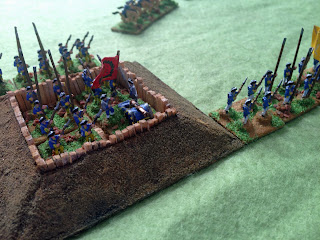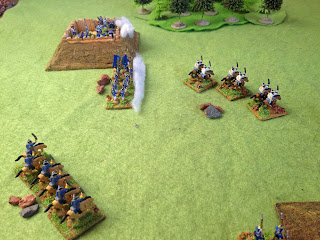The next scenario in One Hour Wargames is an unusual one with some major special rules - the fortified defence. One side starts in strong defensive positions; the other must take them. Both sides get the same number of units, and the defenders get bonus weaponry on their defensive positions to make them extra nasty. However the attackers get the option, once per game, of eliminating all of their on-table units and then getting a second wave of units with which to continue the attack. The scenario boils down to the attacking deciding where to commit their first wave, which is pretty much doomed whichever way you look at it, before going for the refit and starting the second attack. Pull the first wave out too early and the second wave will have too tough a job. Leave it in the field too long and the second wave may not have time to take the objectives.
For this scenario I got my Great Northern War troops out again. The original scenario specifies the objectives as town, but readers of this blog will know that I've recently made a couple of redoubts which were, it has to be said, put together with this scenario in mind.
I rolled the forces and the Swedes ended up defending, with four infantry regiments, one cavalry regiment and a battery of artillery. They set up as shown below; infantry in the forward redoubt, and artillery in the further one, each with a unit of infantry in direct support. A regiment of infantry was placed behind the forward redoubt as reinforcements, whilst cavalry covered the gap between them.
The artillery redoubt. The attackers had a lot of ground to cover to reach this one, so the longer range of the artillery would be useful. In addition, if it was ignored it could provide covering fire to the forward redoubt.
The infantry redoubt. The artillery piece in it represents the additional weaponry the scenario specifies. This pretty much fires the same as an infantry unit, making each redoubt a deadly opponent.
The Russians attacked with four regiments of infantry, one of cavalry and one of dragoons. The second wave is the same force; it occurred to me afterwards that it could be interesting to roll for the second wave as a different force, or roll two forces at the beginning of the game and decide which to commit in each wave.
The Russians had a plan - always a good idea. This was to overwhelm the forward redoubt with a massed infantry assault, whilst using the dragoons and cavalry to screen the flanks and try to inflict as much damage on the troops between the redoubts as possible. If a redoubt falls the extra weaponry is lost, so even if it is reinforced it becomes less dangerous. The aim of the plan was to eliminate the garrison of the first redoubt and with it the extra weaponry. This would then give the second wave a chance to take on the reinforcements that were waiting to reoccupy it whilst also attacking the second redoubt.
The Russians charged forward into a hail of musketry and cannon fire.
Their horse moved quickly, heading for the units covering the gap between the redoubts.
The first Russian assault went in ..
... and was repulsed. There is no infantry close combat in these rules; the assault was pushed in close so that the second line of Russian troops would already be in close range if the first line was lost.
The opposing cavalry clashed in the centre, but the Russian dragoons were driven off by heavy fire from the artillery redoubt and its supporting infantry.
The Russian cavalry fell back, and was also driven off by fire from the artillery redoubt. However the Swedish cavalry was far from fresh.
The defenders of the infantry redoubt poured volley after volley into the attacking Russians, driving off another unit. Their supporting infantry also held firm, preventing the Russians from bringing more fire to bear on the defences.
The Russian first wave was faltering now and was down to one active unit.
A final volley saw that off as well.
It was now halfway through the game, and the Russians could throw in their second wave because the first no longer existed. The first wave had failed in its objective, however; the lead redoubt was still occupied by its original defenders, albeit that they were only a couple of hits away from defeat. Their supporting infantry was also wavering. However the reserve unit was still waiting to occupy the redoubt; the Russians had to clear it, then deal with the reserves. In addition they had to take the second redoubt - things were not looking good for them.
Two infantry regiments were assigned to finish the assault on the forward redoubt. Their first volley drove off the supporting infantry, but the defenders of the redoubt itself refused to yield. Meanwhile the Russian horse moved rapidly across the field towards the artillery redoubt.
The Russians had to keep their infantry as intact as they could during the long march to the artillery redoubt. So the cavalry and dragoons were assigned the task of acting as a shield to cover them. Whilst the dragoons headed for the redoubt itself, the cavalry charged the supporting infantry.
The Swedish cavalry counterattacked.
The Russians recoiled, rallied and charged the infantry again, whilst the dragoons attacked the redoubt itself.
Again the Swedish cavalry went in, but the sacrifice of the Russian horse had allowed the Russian infantry to come up intact.
The Russian cavalry fled.
Meanwhile the Swedish garrison in the lead redoubt refused to yield, as the Russians attacked again and again.
Both redoubts were now under attack, but time was running out for the Russians.
The attack on the artillery redoubt was limited by the presence of the supporting infantry and the Swedish cavalry. The latter was eventually driven off.
One of the Russian units attacking the lead redoubt fled ...
... but so did the infantry supporting the artillery redoubt.
The defenders of the lead redoubt finally gave in. But the reserves were ready to replace them. and the Russians didn't have the time to eliminate them as well. Victory had pretty much slipped from their grasp.
The redoubt reoccupied - not as strong as before, but enough to hold off the final attacks of the day.
The demoralised Russians fled at the first volley the defenders fired.
In the last turn of the game, though, the artillery redoubt fell.
The Russians had cleared one of the two redoubts, but had lost the battle.
The Swedes settled into their remaining defences.
This is an epic scenario, with the attackers set to take huge losses trying to take the objectives. Ten of the twelve attacking units were lost, whilst the Swedes lost five of their six defending units. The Swedish victory was due to a stubborn defence of the first redoubt, which lasted far longer than hoped for. The supporting infantry tied up the attacking Russians for longer than expected, and the garrison refused to quit. This was coupled with some good combat rolls early in the game, which saw the initial Russian wave decimated before it could inflict much damage. The second wave of attackers had a tough job on their hands, with their resources stretched too thin to be able to be truly decisive anywhere. The Swedish cavalry was, as ever, very useful, threatening units in the centre and forcing them to turn their attention to driving off charges instead of attacking the defences.
That said, the version of the rules I am using, which has saving rolls for cover rather than a straight halving of casualties, could have seen the defenders losing very badly; a couple of turns of poor saves could have seen them defeated fairly quickly and the Russians in a far stronger position when their second attack went in.
To some extent the Russian's force wasn't the best for the mission they had. The dragoons could have been dismounted, but their firepower isn't as good as that of the infantry. A battery of artillery would have been more useful, allowing the first wave to pick off and weaken defending units from long range. The Swedes, however, really got just the force they needed to mount an effective defence. That's the fun of these scenarios in some respect; the troops you roll each time you play it can have a major influence on how the action plays out and what your options are.
This now sees me halfway through the scenarios in the book.
Follow the rest of the scenario refights HERE










































































